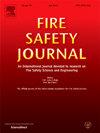Bond shear modulus in reinforced concrete at high temperature: General trends from test results
IF 3.4
3区 工程技术
Q2 ENGINEERING, CIVIL
引用次数: 0
Abstract
The scanty attention devoted so far to bond shear modulus (secant or tangent slope of the loading branch of the bond-slip curve) limits the ability to numerically model such phenomena as tension stiffening, that controls the stiffness of cracked RC structures even past a fire. To improve the knowledge of bond shear modulus at high temperature, the bond stress-bar slip curves resulting from the tests of eleven selected experimental campaigns spanning a forty-year period are re-examined in this paper. Bond shear modulus is derived as the initial slope of the bond stress-bar slip curves of stressed or unstressed specimens in either hot or residual conditions. The criteria to compare the test results coming from very different experimental campaigns are discussed at length. Bond shear modulus is shown to be a decreasing function of the residual compressive strength of the concrete (at high temperature or past cooling). The envelopes of the test data allow to assess the roles of bar diameter and concrete grade. Trend curves are derived for normal-strength and high-strength/high-performance concretes, as a first necessary step for the formulation of parametric design-oriented laws, that may be useful to model tension stiffening and to describe the distribution of the bond stresses in long anchored bars. A numerical example is also developed and the consistency with EuroCode EC2 is checked.
求助全文
约1分钟内获得全文
求助全文
来源期刊

Fire Safety Journal
工程技术-材料科学:综合
CiteScore
5.70
自引率
9.70%
发文量
153
审稿时长
60 days
期刊介绍:
Fire Safety Journal is the leading publication dealing with all aspects of fire safety engineering. Its scope is purposefully wide, as it is deemed important to encourage papers from all sources within this multidisciplinary subject, thus providing a forum for its further development as a distinct engineering discipline. This is an essential step towards gaining a status equal to that enjoyed by the other engineering disciplines.
 求助内容:
求助内容: 应助结果提醒方式:
应助结果提醒方式:


